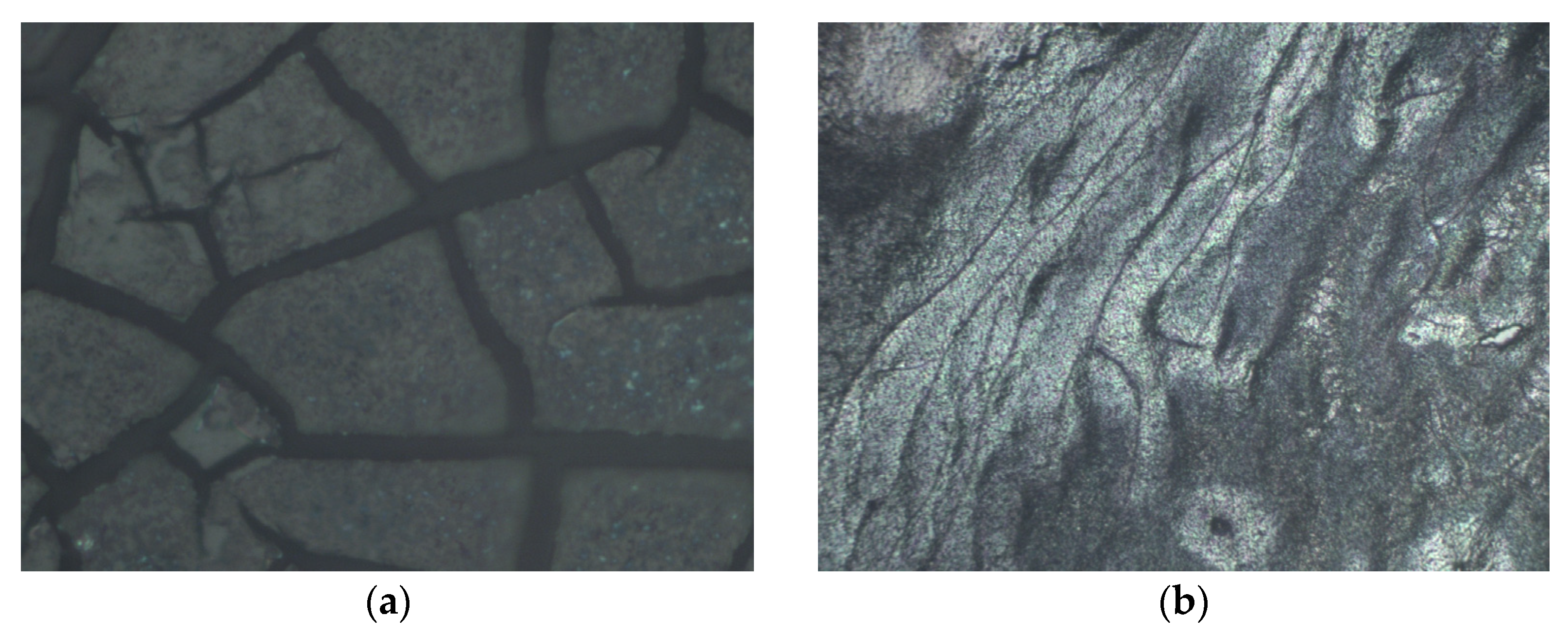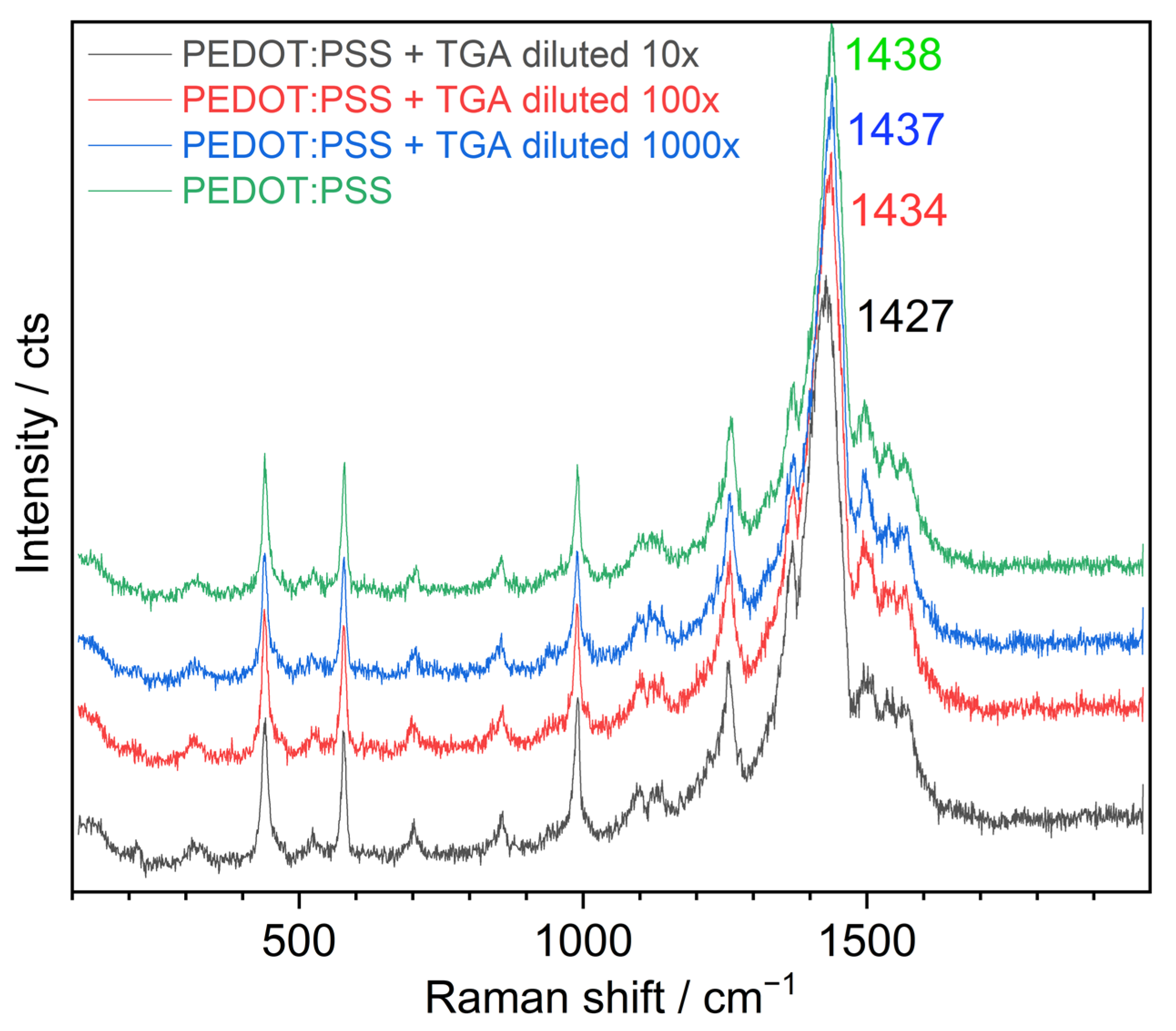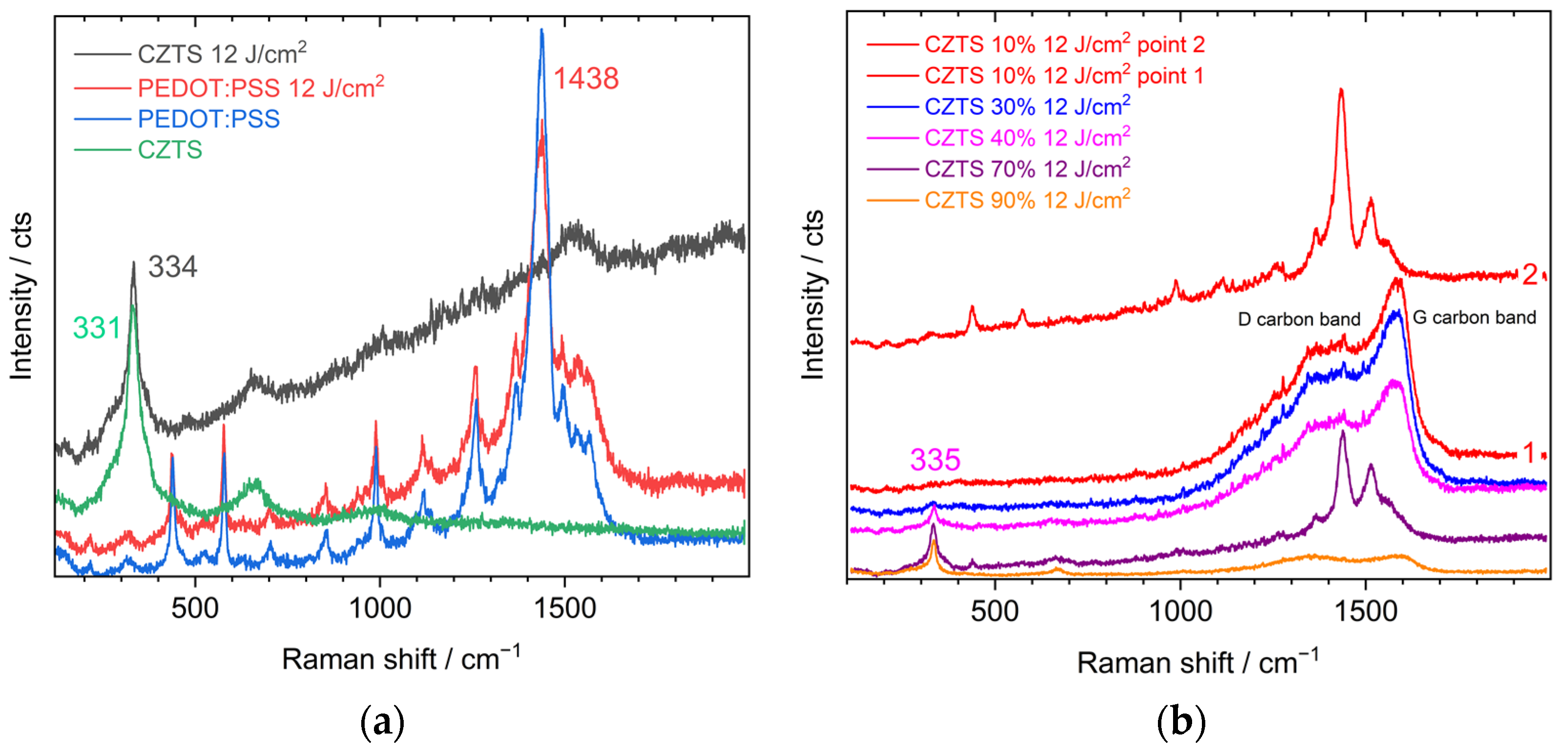Raman Spectroscopy and Thermoelectric Characterization of Composite Thin Films of Cu2ZnSnS4 Nanocrystals Embedded in a Conductive Polymer PEDOT:PSS
Abstract
:1. Introduction
2. Materials and Methods
3. Results and Discussion
3.1. Preparing Composites of CZTS NCs with PEDOT:PSS and Their Raman Spectra
3.2. Flash Lamp Annealing of Composite Films
3.3. The Effect of Laser Power
3.4. Thermoelectrical Studies
4. Conclusions
Supplementary Materials
Author Contributions
Funding
Institutional Review Board Statement
Informed Consent Statement
Data Availability Statement
Acknowledgments
Conflicts of Interest
References
- Romanyuk, Y.E.; Haass, S.G.; Giraldo, S.; Placidi, M.; Tiwari, D.; Fermin, D.J.; Hao, X.; Xin, H.; Schnabel, T.; Kauk-Kuusik, M.; et al. Doping and alloying of kesterites. J. Phys. Energy 2019, 1, 044004. [Google Scholar] [CrossRef] [Green Version]
- Stroyuk, O.; Raevskaya, A.; Gaponik, N. Solar light harvesting with multinary metal chalcogenide nanocrystals. Chem. Soc. Rev. 2018, 47, 5354–5422. [Google Scholar] [CrossRef]
- Ghosh, S.; Yadav, R. Future of photovoltaic technologies: A comprehensive review. Sustain. Energy Technol. Assess. 2021, 47, 101410. [Google Scholar] [CrossRef]
- Giraldo, S.; Jehl, Z.; Placidi, M.; Izquierdo-Roca, V.; Pérez-Rodríguez, A.; Saucedo, E. Progress and Perspectives of Thin Film Kesterite Photovoltaic Technology: A Critical Review. Adv. Mater. 2019, 31, e1806692. [Google Scholar] [CrossRef] [Green Version]
- Márquez, J.; Neuschitzer, M.; Dimitrievska, M.; Gunder, R.; Haass, S.; Werner, M.; Romanyuk, Y.; Schorr, S.; Pearsall, N.; Forbes, I. Systematic compositional changes and their influence on lattice and optoelectronic properties of Cu2ZnSnSe4 kesterite solar cells. Sol. Energy Mater. Sol. Cells 2016, 144, 579–585. [Google Scholar] [CrossRef]
- Sengar, B.S.; Garg, V.; Kumar, A.; Awasthi, V.; Kumar, S.; Atuchin, V.V.; Mukherjee, S. Band alignment of Cd-free (Zn, Mg)O layer with Cu2ZnSn(S,Se)4 and its effect on the photovoltaic properties. Opt. Mater. 2018, 84, 748–756. [Google Scholar] [CrossRef]
- Kokh, K.A.; Atuchin, V.V.; Adichtchev, S.V.; Gavrilova, T.A.; Bakhadur, A.M.; Klimov, A.O.; Korolkov, I.V.; Kuratieva, N.; Mukherjee, S.; Pervukhina, N.V.; et al. Cu2ZnSnS4 crystal growth using an SnCl2 based flux. CrystEngComm 2020, 23, 1025–1032. [Google Scholar] [CrossRef]
- Sengar, B.S.; Garg, V.; Siddharth, G.; Kumar, A.; Pandey, S.K.; Dubey, M.; Atuchin, V.V.; Kumar, S.; Mukherjee, S. Improving the Cu2ZnSn(S,Se)4-Based Photovoltaic Conversion Efficiency by Back-Contact Modification. IEEE Trans. Electron Devices 2021, 68, 2748–2752. [Google Scholar] [CrossRef]
- Akhavan, V.A.; Goodfellow, B.W.; Panthani, M.G.; Steinhagen, C.; Harvey, T.B.; Stolle, C.J.; Korgel, B.A. Colloidal CIGS and CZTS nanocrystals: A precursor route to printed photovoltaics. J. Solid State Chem. 2012, 189, 2–12. [Google Scholar] [CrossRef]
- Dzhagan, V.; Kapush, O.; Mazur, N.; Havryliuk, Y.; Danylenko, M.I.; Budzulyak, S.; Yukhymchuk, V.; Valakh, M.; Litvinchuk, A.; Zahn, D.R.T. Colloidal Cu-Zn-Sn-Te Nanocrystals: Aqueous Synthesis and Raman Spectroscopy Study. Nanomaterials 2021, 11, 2923. [Google Scholar] [CrossRef] [PubMed]
- Syafiq, U.; Ataollahi, N.; Scardi, P. Progress in CZTS as hole transport layer in perovskite solar cell. Sol. Energy 2019, 196, 399–408. [Google Scholar] [CrossRef]
- Maurya, D.K.; Sikarwar, S.; Chaudhary, P.; Angaiah, S.; Yadav, B.C. Synthesis and Characterization of Nanostructured Copper Zinc Tin Sulphide (CZTS) for Humidity Sensing Applications. IEEE Sens. J. 2019, 19, 2837–2846. [Google Scholar] [CrossRef]
- Zheng, H.; Liu, Y. Photocatalytic H2 evolution of selective phase CZTS synthesized by ultrasonic spray pyrolysis method. J. Mater. Sci. Mater. Electron. 2021, 32, 4125–4131. [Google Scholar] [CrossRef]
- Isotta, E.; Syafiq, U.; Ataollahi, N.; Chiappini, A.; Malerba, C.; Luong, S.; Trifiletti, V.; Fenwick, O.; Pugno, N.M.; Scardi, P. Thermoelectric properties of CZTS thin films: Effect of Cu–Zn disorder. Phys. Chem. Chem. Phys. 2021, 23, 13148–13158. [Google Scholar] [CrossRef]
- Skelton, J.M.; Jackson, A.J.; Dimitrievska, M.; Wallace, S.K.; Walsh, A. Vibrational spectra and lattice thermal conductivity of kesterite-structured Cu2ZnSnS4 and Cu2ZnSnSe4. APL Mater. 2015, 3, 041102. [Google Scholar] [CrossRef] [Green Version]
- Fan, X.; Nie, W.; Tsai, H.; Wang, N.; Huang, H.; Cheng, Y.; Wen, R.; Ma, L.; Yan, F.; Xia, Y. PEDOT:PSS for Flexible and Stretchable Electronics: Modifications, Strategies, and Applications. Adv. Sci. 2019, 6, 1900813. [Google Scholar] [CrossRef] [Green Version]
- Sun, K.; Zhang, S.; Li, P.; Xia, Y.; Zhang, X.; Du, D.; Isikgor, F.H.; Ouyang, J. Review on application of PEDOTs and PEDOT:PSS in energy conversion and storage devices. J. Mater. Sci. Mater. Electron. 2015, 26, 4438–4462. [Google Scholar] [CrossRef]
- Kondratenko, S.V.; Lysenko, V.S.; Gomeniuk, Y.V.; Kondratenko, O.S.; Kozyrev, Y.N.; Selyshchev, O.V.; Dzhagan, V.; Zahn, D.R.T. Improved rectification and transport properties of hybrid PEDOT:PSS/Ge/Si heterojunctions with Ge nanoclusters. J. Appl. Phys. 2020, 128, 085503. [Google Scholar] [CrossRef]
- Chang, S.H.; Chiang, C.-H.; Kao, F.-S.; Tien, C.-L.; Wu, C.-G. Unraveling the Enhanced Electrical Conductivity of PEDOT:PSS Thin Films for ITO-Free Organic Photovoltaics. IEEE Photon- J. 2014, 6, 1–7. [Google Scholar] [CrossRef]
- Kondratenko, S.; Lysenko, V.; Gomeniuk, Y.V.; Kondratenko, O.; Kozyrev, Y.; Selyshchev, O.; Dzhagan, V.; Zahn, D.R.T. Charge Carrier Transport, Trapping, and Recombination in PEDOT:PSS/n-Si Solar Cells. ACS Appl. Energy Mater. 2019, 2, 5983–5991. [Google Scholar] [CrossRef]
- Yemata, T.A.; Zheng, Y.; Kyaw, A.K.K.; Wang, X.; Song, J.; Chin, W.S.; Xu, J. Modulation of the doping level of PEDOT:PSS film by treatment with hydrazine to improve the Seebeck coefficient. RSC Adv. 2020, 10, 1786–1792. [Google Scholar] [CrossRef] [PubMed] [Green Version]
- Luo, J.; Billep, D.; Waechtler, T.; Otto, T.; Toader, M.; Gordan, O.; Sheremet, E.; Martin, J.; Hietschold, M.; Zahn, D.R.T.; et al. Enhancement of the thermoelectric properties of PEDOT:PSS thin films by post-treatment. J. Mater. Chem. A 2013, 1, 7576–7583. [Google Scholar] [CrossRef]
- Luo, J.; Billep, D.; Blaudeck, T.; Sheremet, E.; Rodriguez, R.D.; Zahn, D.R.T.; Toader, M.; Hietschold, M.; Otto, T.; Gessner, T. Chemical post-treatment and thermoelectric properties of poly(3,4-ethylenedioxylthiophene):poly(styrenesulfonate) thin films. J. Appl. Phys. 2014, 115, 054908. [Google Scholar] [CrossRef]
- Selyshchev, O.; Havryliuk, Y.; Valakh, M.Y.; Yukhymchuk, V.O.; Raievska, O.; Stroyuk, O.L.; Dzhagan, V.; Zahn, D.R.T. Raman and X-ray Photoemission Identification of Colloidal Metal Sulfides as Potential Secondary Phases in Nanocrystalline Cu2ZnSnS4 Photovoltaic Absorbers. ACS Appl. Nano Mater. 2020, 3, 5706–5717. [Google Scholar] [CrossRef]
- Dimitrievska, M.; Oliva, F.; Guc, M.; Giraldo, S.; Saucedo, E.; Pérez-Rodríguez, A.; Izquierdo-Roca, V. Defect characterisation in Cu2ZnSnSe4 kesterites via resonance Raman spectroscopy and the impact on optoelectronic solar cell properties. J. Mater. Chem. A 2019, 7, 13293–13304. [Google Scholar] [CrossRef]
- Havryliuk, Y.; Valakh, M.Y.; Dzhagan, V.; Greshchuk, O.; Yukhymchuk, V.; Raevskaya, A.; Stroyuk, O.; Selyshchev, O.; Gaponik, N.; Zahn, D.R.T. Raman characterization of Cu2ZnSnS4 nanocrystals: Phonon confinement effect and formation of CuxS phases. RSC Adv. 2018, 8, 30736–30746. [Google Scholar] [CrossRef] [Green Version]
- Dimitrievska, M.; Boero, F.; Litvinchuk, A.P.; Delsante, S.; Borzone, G.; Perez-Rodriguez, A.; Izquierdo-Roca, V. Structural Polymorphism in “Kesterite” Cu2ZnSnS4: Raman Spectroscopy and First-Principles Calculations Analysis. Inorg. Chem. 2017, 56, 3467–3474. [Google Scholar] [CrossRef]
- Gurieva, G.; Többens, D.; Valakh, M.Y.; Schorr, S. Cu-Zn disorder in Cu2ZnGeSe4: A complementary neutron diffraction and Raman spectroscopy study. J. Phys. Chem. Solids 2016, 99, 100–104. [Google Scholar] [CrossRef]
- Guc, M.; Litvinchuk, A.P.; Levcenko, S.; Valakh, M.Y.; Bodnar, I.V.; Dzhagan, V.M.; Izquierdo-Roca, V.; Arushanov, E.; Pérez-Rodríguez, A. Optical phonons in the kesterite Cu2ZnGeS4 semiconductor: Polarized Raman spectroscopy and first-principle calculations. RSC Adv. 2016, 6, 13278–13285. [Google Scholar] [CrossRef]
- Litvinchuk, A.P.; Dzhagan, V.M.; Yukhymchuk, V.O.; Valakh, M.Y.; Babichuk, I.S.; Parasyuk, O.V.; Piskach, L.V.; Gordan, O.D.; Zahn, D.R.T. Electronic structure, optical properties, and lattice dynamics of orthorhombic Cu2CdGeS4 and Cu2CdSiS4 semiconductors. Phys. Rev. B 2014, 90, 165201. [Google Scholar] [CrossRef]
- Babichuk, I.S.; Romaniuk, Y.A.; Golovynskyi, S.; Hurtavy, V.G.; Mudryi, A.V.; Zhivulko, V.D.; Babichuk, I.V.; Xu, C.; Lin, C.; Cao, M.; et al. Spectroscopy and Theoretical Modeling of Phonon Vibration Modes and Band Gap Energy of Cu2ZnSn(SxSe1–x)4 Bulk Crystals and Thin Films. ACS Omega 2021, 6, 29137–29148. [Google Scholar] [CrossRef] [PubMed]
- Babichuk, I.S.; Semenenko, M.O.; Caballero, R.; Hladkovskyi, V.V.; Datsenko, O.I.; Yeshchenko, O.A.; Babichuk, I.V.; Lin, C.; Qiu, Y.; Redko, R.A.; et al. Influence of hydrogen plasma treatment on secondary phases in CZTS thin films for energy harvesting. Mater. Today Commun. 2021, 28, 102664. [Google Scholar] [CrossRef]
- Singh, M.; Rana, S.; Agarwal, S. Light induced morphological reforms in thin film of advanced nano-materials for energy generation: A review. Opt. Laser Technol. 2020, 129, 106284. [Google Scholar] [CrossRef]
- Williams, B.A.; Smeaton, M.A.; Holgate, C.S.; Trejo, N.D.; Francis, L.F.; Aydil, E.S. Intense pulsed light annealing of copper zinc tin sulfide nanocrystal coatings. J. Vac. Sci. Technol. A 2016, 34, 051204. [Google Scholar] [CrossRef]
- Stroyuk, O.; Raevskaya, A.; Selyshchev, O.; Dzhagan, V.; Gaponik, N.; Zahn, D.R.T.; Eychmüller, A. “Green” Aqueous Synthesis and Advanced Spectral Characterization of Size-Selected Cu2ZnSnS4 Nanocrystal Inks. Sci. Rep. 2018, 8, 13677. [Google Scholar] [CrossRef] [PubMed] [Green Version]
- Havryliuk, Y.; Selyshchev, O.; Valakh, M.; Raevskaya, A.; Stroyuk, O.; Schmidt, C.; Dzhagan, V.; Zahn, D.R.T. Raman study of flash-lamp annealed aqueous Cu2ZnSnS4 nanocrystals. Beilstein J. Nanotechnol. 2019, 10, 222–227. [Google Scholar] [CrossRef] [Green Version]
- Almeida, P.; Izumi, C.; Santos, H.; Sant’Ana, A.C. Spectroscopic Characterization of Pedot:Pss Conducting Polymer by Resonance Raman and SERRS Spectroscopies. Quim. Nova 2019, 42, 1073–1080. [Google Scholar] [CrossRef]
- Sakamoto, S.; Okumura, M.; Zhao, Z.; Furukawa, Y. Raman spectral changes of PEDOT–PSS in polymer light-emitting diodes upon operation. Chem. Phys. Lett. 2005, 412, 395–398. [Google Scholar] [CrossRef]
- Lee, H.; Kim, Y.; Cho, H.; Lee, J.-G.; Kim, J.H. Improvement of PEDOT:PSS linearity via controlled addition process. RSC Adv. 2019, 9, 17318–17324. [Google Scholar] [CrossRef] [Green Version]
- Pathak, C.; Singh, J.; Singh, R. Effect of dimethyl sulfoxide on the electrical properties of PEDOT:PSS/n-Si heterojunction diodes. Curr. Appl. Phys. 2015, 15, 528–534. [Google Scholar] [CrossRef]
- Stavytska-Barba, M.; Kelley, A.M. Surface Enhanced Raman Study of the Interaction of Organic Solar Cell Components with Plasmonically Active Nanoparticles. In Frontiers in Optics 2010/Laser Science XXVI; OSA: Washington, DC, USA, 2010; p. LWC4. [Google Scholar] [CrossRef]
- Alessandri, I.; Torricelli, F.; Cerea, B.; Speziani, M.; Romele, P.; Vassalini, I. Why PEDOT: PSS Should Not Be Used for Raman Sensing of Redox States (and How It Could Be). ChemRxiv 2022, 21, 1–28. [Google Scholar] [CrossRef]
- Vasin, A.; Kysil, D.; Rusavsky, A.; Isaieva, O.; Zaderko, A.; Nazarov, A.; Lysenko, V. Synthesis and Luminescent Properties of Carbon Nanodots Dispersed in Nanostructured Silicas. Nanomaterials 2021, 11, 3267. [Google Scholar] [CrossRef] [PubMed]
- Ferrari, A.C.; Robertson, J. Interpretation of Raman Spectra of Disordered and Amorphous Carbon. Phys. Rev. B 2000, 61, 14295. [Google Scholar] [CrossRef] [Green Version]
- Kanwat, A.; Jang, J. Enhanced organic photovoltaic properties via structural modifications in PEDOT:PSS due to graphene oxide doping. Mater. Res. Bull. 2016, 74, 346–352. [Google Scholar] [CrossRef]





| Sample | Conductivity [S/cm] | Seebeck Coefficient (S) [µV/K] | Power Factor (P) [µW/cmK2] | |
|---|---|---|---|---|
| PEDOT:PSS | Pristine FLA | 0.6 2.3 | 0.44 21.0 | 0.0000001 0.001 |
| PEDOT:PSS 50% + CZTS 50% | Pristine FLA | 1.4 24.0 | 20.0 37.0 | 0.0006 0.03 |
| (PEDOT:PSS + DMSO) + 50% CZTS 50% | Pristine FLA | 9.0 70.83 | 29.1 24.14 | 0.007 0.041 |
Disclaimer/Publisher’s Note: The statements, opinions and data contained in all publications are solely those of the individual author(s) and contributor(s) and not of MDPI and/or the editor(s). MDPI and/or the editor(s) disclaim responsibility for any injury to people or property resulting from any ideas, methods, instructions or products referred to in the content. |
© 2022 by the authors. Licensee MDPI, Basel, Switzerland. This article is an open access article distributed under the terms and conditions of the Creative Commons Attribution (CC BY) license (https://creativecommons.org/licenses/by/4.0/).
Share and Cite
Havryliuk, Y.; Dzhagan, V.; Karnaukhov, A.; Selyshchev, O.; Hann, J.; Zahn, D.R.T. Raman Spectroscopy and Thermoelectric Characterization of Composite Thin Films of Cu2ZnSnS4 Nanocrystals Embedded in a Conductive Polymer PEDOT:PSS. Nanomaterials 2023, 13, 41. https://doi.org/10.3390/nano13010041
Havryliuk Y, Dzhagan V, Karnaukhov A, Selyshchev O, Hann J, Zahn DRT. Raman Spectroscopy and Thermoelectric Characterization of Composite Thin Films of Cu2ZnSnS4 Nanocrystals Embedded in a Conductive Polymer PEDOT:PSS. Nanomaterials. 2023; 13(1):41. https://doi.org/10.3390/nano13010041
Chicago/Turabian StyleHavryliuk, Yevhenii, Volodymyr Dzhagan, Anatolii Karnaukhov, Oleksandr Selyshchev, Julia Hann, and Dietrich R. T. Zahn. 2023. "Raman Spectroscopy and Thermoelectric Characterization of Composite Thin Films of Cu2ZnSnS4 Nanocrystals Embedded in a Conductive Polymer PEDOT:PSS" Nanomaterials 13, no. 1: 41. https://doi.org/10.3390/nano13010041
APA StyleHavryliuk, Y., Dzhagan, V., Karnaukhov, A., Selyshchev, O., Hann, J., & Zahn, D. R. T. (2023). Raman Spectroscopy and Thermoelectric Characterization of Composite Thin Films of Cu2ZnSnS4 Nanocrystals Embedded in a Conductive Polymer PEDOT:PSS. Nanomaterials, 13(1), 41. https://doi.org/10.3390/nano13010041






